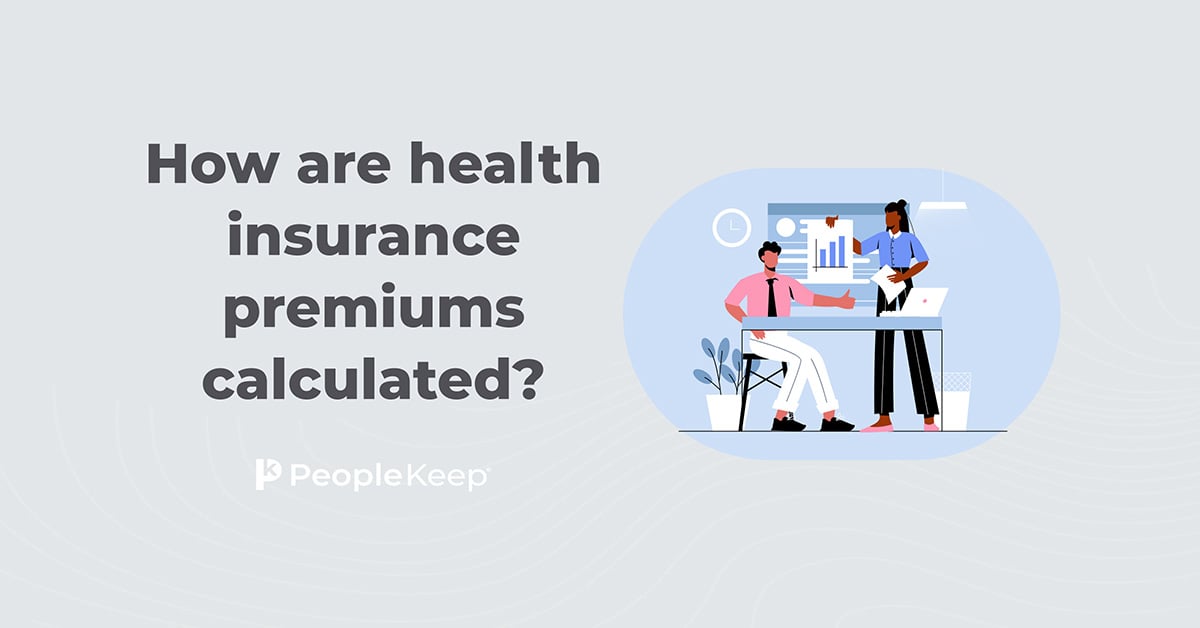What is a health insurance premium?
By Chase Charaba on April 15, 2024 at 11:24 AM
As more individuals and families become active healthcare consumers, knowing key healthcare terms and how they affect your health insurance costs is essential. One of the most critical terms to understand is health insurance premiums. Paying health insurance premiums is necessary to ensure your coverage is active when you need it most.
This blog post will explain what a health insurance premium is, how much premiums typically cost, and how different factors and plans affect premium amounts.
Takeaways from this blog post:
- A health insurance premium is the amount of money you pay for health insurance coverage, typically monthly.
- Choosing the right health insurance plan for your needs and budget will help you avoid significant financial burdens.
- Employer-sponsored health benefits like health reimbursement arrangements (HRAs) can help you pay for your qualifying health insurance premiums.
This blog post was updated on December 18, 2025, with 2026 premiums.
Health insurance premium definition
Health insurance premiums are the amount you pay to a health insurance company to maintain your coverage, and are generally paid monthly. This fee is critical to keep your insurance active, enabling you to receive the healthcare services outlined in your plan.
Much like premiums for other types of insurance, like car insurance, health insurance premiums are periodically due whether you use your coverage or not.
Premiums may not be your only medical expense. Each health insurance plan is unique in how it splits the cost of your care between you and your insurance carrier. Keep an eye on factors like out-of-pocket maximums and whether certain costs like prescription drugs or doctor visits have copayments.
How does a health insurance premium work?
Now that we’ve explained what premiums are, let’s review how they work. Health insurance protects individuals from the high costs associated with medical care. At its core, it involves paying a health insurance premium in exchange for coverage when you need it most.
Here’s how the process works:
- Choose a plan: Whether your employer offers you a group health plan or you want to enroll in an individual health insurance policy, you’ll need to decide which plan to enroll in. You’ll want to choose a plan that best fits your needs and budget. Consider factors like premiums, coinsurance, deductibles, and whether your preferred doctors and specialists are in the plan’s network.
- Pay the premium: Once you select or enroll in a plan, the insurer may expect you to pay your first month’s premium immediately. Other times, you’ll wait until the plan starts to make your first premium payment. To maintain coverage, policyholders must pay their premiums by the due date. Most premiums are due monthly, but your plan may have annual, quarterly, fortnightly, or weekly payments. By imposing a deductible and premiums on all policyholders in a group—regardless of whether the policyholders are part of a group health plan or enrolled in an individual policy—insurers can accumulate enough funds to cover the risk of insuring the population.
- Seek medical care and services: When you need medical care, you’ll pay for that care until you reach your deductible. Then, your insurance company will begin to cover the costs of healthcare.
- The insurer covers eligible costs: The insurer pays for medical services, prescriptions, and treatments the plan covers, minus any deductibles, copayments, or coinsurance, using the money it earns from sources like premiums.
How much is the typical health insurance premium?
Health insurance premiums vary by state, plan type, and other factors, but KFF1 found the national average benchmark plan for individual health insurance in 2024 has an average monthly premium of $477 for single coverage, which totals to an annual cost of $5,724.
KFF also found2 that the average annual premium for employer-sponsored group health insurance in 2023 was $8,435 for single coverage and $23,968 for family coverage.
What factors affect premiums?
Several factors influence health insurance premium costs. The healthcare options you select and the composition of your family, such as the number and age of dependents, significantly shape your premium. Additionally, premiums vary according to the level of coverage you require.
Age is another significant factor in setting premiums. Insurers on the individual insurance marketplaces can set premiums up to three times higher for older individuals than younger ones, and group plans have more flexibility in setting higher prices for older adults.
Network choice also impacts your monthly premium. Some networks featuring a broader range of medical services or facilities may come with higher costs.
Residents in rural areas may face higher premiums due to a lack of competition among health insurance companies, affecting regional benchmarks.
Tobacco use can also impact your premiums, as tobacco use can increase your risk of certain costly health conditions and, therefore, increase the risk to the insurer.
Carriers that offer individual health insurance plans can’t use factors like medical history or current health status to determine premiums.
Learn more about how insurers calculate premiums in our blog post.
Types of health insurance plans and their premiums
When choosing a health insurance plan, the premiums can vary based on the type of plan you select or enroll in. The primary types of health plans include health maintenance organizations (HMOs), preferred provider organizations (PPOs), exclusive provider organizations (EPOs), and point of service (POS) plans. Each plan offers different features and network options that can affect premiums.
HMO plans typically require policyholders to stay within a specific network of healthcare providers. They may necessitate a primary care physician referral to see specialists. Due to these limitations, HMOs often have lower premiums.
In contrast, PPOs offer more flexibility, allowing members to see providers both in and out of network, including specialists without a referral, generally resulting in higher premiums.
EPOs share similarities with HMOs and PPOs, restricting members to a network of providers but often enabling individuals to see specialists without requiring referrals. This creates a more balanced premium cost. POS plans are similar in that they combine aspects of HMOs and PPOs, with costs varying based on care from in or out-of-network providers.
However, plan differences don’t stop there. Depending on whether your plan is a group plan, individual plan, or government program, your premiums can also look different. Let’s review these differences below.
Group health insurance premiums
Group health insurance plans share risk across a broad group that typically consists of employees or members of an organization. Employers provide these plans to their employees. They can be more affordable than other types of plans for larger groups because the risk is spread across a large number of participants. This, in turn, lowers premiums.
Employers often contribute significantly toward the premium, reducing the employee's financial burden, with the remaining portion often deducted from payroll. While this can make premiums more affordable for employees, it puts more costs on the employer.
This becomes an issue for small businesses and nonprofits with more limited budgets, as they don’t have enough employees to create a large enough risk pool to lower premiums. This leads to many small organizations being unable to offer health coverage. Thankfully, employers can offer a health reimbursement arrangement (HRA) to reimburse employees for individual health insurance premiums, helping them save money compared to small group coverage.
Individual health insurance premiums
Individual health insurance policies are an excellent option for individuals without access to an employer-sponsored group plan or those with an HRA. These policies require the policyholder to pay premiums directly to the insurance company.
The public exchanges categorize individual plans by metallic tiers, either bronze, silver, gold, or platinum. Bronze plans have the lowest premiums but higher deductibles and out-of-pocket costs. On the other hand, gold or platinum plans have higher premiums but lower deductibles and out-of-pocket costs.
Individual plans can be more expensive for individuals without employer-sponsored coverage as they’re responsible for paying their entire premium themselves. However, if your employer offers you an HRA, they may be able to reimburse you for your individual health insurance premiums. This helps individuals and small employers save money, as individual health insurance premiums are cheaper than small group coverage in many counties.
Here’s an example of places where individual health insurance premiums are cheaper3 than small group coverage in 2026.
| County | Average monthly premiums for a 27-year-old | Average monthly premiums for a 50-year-old | ||
| Small group coverage | Silver-level individual coverage | Small group coverage | Silver-level individual coverage | |
| Cuyahoga County, OH (Cleveland) | $745.66 | $383.14 | $1,270.75 | $652.95 |
| Denver County, CO | $365.39 | $346.78 | $622.70 | $590.98 |
| Bernalillo County, NM (Albuquerque) | $405.49 | $360.75 | $691.04 | $614.79 |
| Santa Clara County, CA (San Jose) | $453.94 | $423.53 | $773.61 | $721.78 |
| Hennepin County, MN (Minneapolis) | $346.59 | $314.64 | $590.67 | $536.21 |
| Franklin County, OH (Columbus) | $871.86 | $352.34 | $1,485.83 | $600.46 |
| Marion County, IN (Indianapolis) | $533.24 | $356.34 | $908.75 | $607.27 |
| Fulton County, GA (Atlanta) | $497.21 | $439.99 | $847.35 | $749.82 |
| Jackson County, MO (Kansas City) | $496.72 | $359.82 | $846.51 | $613.20 |
| Virginia Beach, VA | $382.39 | $311.82 | $651.68 | $531.41 |
Additionally, individuals can get assistance for individual health insurance premiums on the Affordable Care Act-established exchanges from the federal government. These premium tax credits help qualifying individuals lower their monthly premiums through advance subsidies each month or as a refund on their tax returns.
Learn more about premium tax credits in our blog post.
Government health insurance program premiums
Government health insurance programs, such as Medicare, Medicaid, and the Children’s Health Insurance Program (CHIP), serve various segments of the population based on age, income, or special conditions.
Premiums for these programs differ as they’re government-subsidized. For instance, many individuals on Medicaid may pay very low premiums or none at all. In states with expanded Medicare under the ACA, more low-income individuals qualify for coverage, often with lower premiums.
How do I see how much my premium will be?
When considering a health plan, it’s essential to know the cost of the premium. If you’re enrolling in an individual policy from the marketplace, you can usually see the expected premium cost on the exchange. You can also download or request a summary of benefits and coverage (SBC), which provides a breakdown of the costs.
For other types of coverage, your employer may provide you with an SBC to review before enrolling in the policy. You can also always check the health plan’s website or other materials.
How can I lower my premiums?
Maintaining affordable health insurance premiums is a key concern for many individuals. Carefully choosing your health insurance plan is the first step in managing costs. You should enroll in the plan that best fits your needs and budget.
If you want a plan with lower premiums, you can opt for one that covers essential health benefits but has a more restricted network or higher deductible. High deductible health plans (HDHPs) come with higher out-of-pocket costs but lower premiums. These plans are great for individuals with fewer expected healthcare needs who just want coverage in the event of an emergency. Individuals wanting to open a health savings account (HSA) to save money for future medical expenses must have an HSA-qualified HDHP to contribute.
Catastrophic health plans are another option for individuals younger than 30 or those 30 and older who experience qualifying financial hardships. These plans have low premiums but high deductibles and out-of-pocket maximums. These plans are ideal for those with little to no expected healthcare costs.
Premium tax credits are also available to qualifying individuals and families on the Health Insurance Marketplace.
If your employer offers you a stand-alone HRA like a qualified small employer HRA (QSEHRA) or individual coverage HRA (ICHRA), they can reimburse you for your individual health insurance premiums up to your allowance amount.
Finally, another strategy is to engage in preventive healthcare. Many plans are starting to offer rewards programs or discounts for policyholders who get routine wellness visits and screenings, which can lead to better health and reduce medical costs in the long term.
For tobacco users, quitting can bolster their health and reduce their premiums, as insurers charge more for tobacco users.
Can an HRA cover my premiums?
Health reimbursement arrangements (HRAs) allow employers to reimburse their employees for more than 200 qualifying medical expenses tax-free. Depending on the type of HRA they offer, this can include health insurance premiums.
QSEHRAs and ICHRAs allow employers to reimburse employees for individual health insurance premiums. However, a group coverage HRA (GCHRA), which pairs with a traditional group health plan, can’t reimburse employees for premiums of any kind.
Conclusion
Understanding health insurance premiums is essential for individuals to make informed decisions about their healthcare options. By knowing how premiums work and what factors influence their cost, individuals can choose a plan that fits their needs and budget.
This blog post was originally published on November 13, 2014. It was last updated on April 15, 2024.
2. https://www.kff.org/report-section/ehbs-2023-summary-of-findings/
Check out more resources
See these related articles

How are health insurance premiums calculated?
Ever wonder how health insurance premiums are determined? This comprehensive blog breaks down the factors that influence the cost of your health insurance.

Why do health insurance premiums increase?
Learn why health insurance premiums increase. Discover the factors behind rising costs and what to consider if your health insurance went up.

Guide to premium tax credits for health insurance
See how premium tax credits can lower health insurance costs. Our guide provides the information you need to navigate this important aspect of healthcare.



